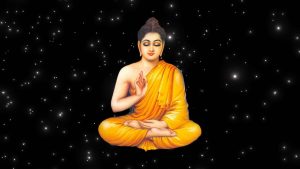📖 The book The Buddha Teaches Once More. Part 4: Decoding Buddhist Sutras. Chapter 42: The Heart Sutra (Prajñāpāramitāhṛdaya Sūtra)
The Heart Sutra (Bát Nhã Tâm Kinh) holds profound spiritual significance. When its hidden meanings are revealed, they unlock a deeper understanding of Emptiness and the true origin of sentient beings.
Minh Nguyet: Venerable Buddha, I have studied the Heart Sutra. In it, there is a teaching about “Form is Emptiness, Emptiness is Form” (“sắc sắc không không”), yet I cannot truly grasp its meaning. Now that I have the opportunity to meet You, I humbly seek Your guidance to illuminate the hidden truths within this sutra.

This sutra is immensely important. The interpretations provided by great Buddhist masters are valuable, and you may study them. However, I will now reveal the hidden essence within this text—this will serve as a key to enlightenment for sentient beings.
1️⃣ Deciphering the Hidden Meaning in the Name “Bát Nhã Tâm Kinh”
First, we must use the Dharani language to decode it. The Heart Sutra is translated into Vietnamese as “Bát Nhã Tâm Kinh”, in which:
- “Bát” is the hidden meaning of “Bát Chánh Đạo”, which refers to the Noble Eightfold Path.
- “Nhã” is the hidden meaning of “nhàn nhã”, which signifies a state of mental ease.
- “Tâm” represents the central focus.
- “Kinh” refers to this scripture.
Thus, the true meaning of the Heart Sutra is that when one understands the core essence of this scripture, they will never fear falling into lower realms, as long as they practice the Noble Eightfold Path diligently on their journey toward Buddhahood.
2️⃣ Interpreting the Hidden Meaning in Key Passages of the Sutra
(Avalokiteśvara Bodhisattva, while practicing deeply the Perfection of Wisdom (Prajñāpāramitā), clearly perceived that all five aggregates are empty, thereby transcending all suffering and distress.)Excerpt from the Heart Sutra
The Five Aggregates (Ngũ Uẩn) consist of:
- Form (Sắc uẩn)
- Sensation (Thọ uẩn)
- Perception (Tưởng uẩn)
- Mental Formations (Hành uẩn)
- Consciousness (Thức uẩn)
The term “uẩn” means a collection or an accumulation of various elements over time.
Everything that exists in the universe and can be perceived is referred to as Dharma. In this context, the Five Aggregates represent all Dharmas.
Thus, the phrase “ngũ uẩn giai không” (the five aggregates are all empty) conveys the idea that all phenomena in the universe lack inherent self-nature. They do not possess independent existence or autonomy over their own being. Instead, they are arranged, governed, and orchestrated within a preordained divine order.
(Śāriputra! Form does not differ from emptiness, and emptiness does not differ from form. Form itself is emptiness, and emptiness itself is form.)Excerpt from the Heart Sutra
The Meaning Behind “Form is Emptiness, Emptiness is Form”
The term “sắc” (form) here refers to color or physical manifestation—what we can see is considered to exist, while what we cannot see is considered to not exist. However, this implies a deeper meaning:
“Existence is non-existence, and non-existence is existence“.
This means that “existence” and “non-existence” are simply two states of the same phenomenon. This principle applies to all things in the universe (all Dharmas).
For example, if one wants to build a multi-story house, they must first have a blueprint.
- Before the house is built, it exists in the form of a plan (emptiness – không).
- After the house is constructed, it exists in physical form (form – sắc).
Thus, the house simultaneously exists in two states:
- One as a conceptual design (emptiness – không).
- One as a completed physical structure (form – sắc).
Therefore, “form is emptiness, and emptiness is form“.
Similarly, the other Four Aggregates (Thọ – Sensation, Tưởng – Perception, Hành – Mental Formations, Thức – Consciousness) also exist in both states of being (Form) and non-being (Emptiness).
The Hidden Meaning Within the Heart Sutra
When decoding the Heart Sutra, it reveals that: Everything in life is preordained and arranged by God the Almighty.
Thus, one only needs to diligently practice the Noble Eightfold Path, and eventually, they will attain Buddhahood and return to the Realm of the Infinite.
Minh Nguyet: Venerable Buddha, I had not realized that all phenomena in this world are arranged by God the Almighty. This secret has actually been recorded in the scriptures for a long time.

You can think of it this way—when constructing a large house, there must first be a blueprint (the state of Emptiness – Không).
Similarly, when speaking about humans, before birth, a being exists as a spirit (hương linh), or soul, which is unseen (Emptiness – Không). But when it reincarnates into the human form, it becomes visible (Form – Có).
However, whether in the state of being seen (Form – Có) or unseen (Emptiness – Không), it remains the same entity—it is still its original essence.
Thus, you must contemplate deeply and trace back to the root cause—where do spirits (hương linh) come from? Who created them?
When practicing self-reflection, we will recognize the existence of a universal law. God the Almighty is the One who creates and governs all phenomena.
I will now continue to explain other hidden meanings within the Heart Sutra.
(Śāriputra, all dharmas are marked with emptiness; they are neither born nor destroyed, neither defiled nor pure, neither increasing nor decreasing.)Excerpt from the Heart Sutra
Neither Born Nor Destroyed (Bất sanh bất diệt)
This means that sentient beings do not come into existence on their own, nor do they disappear on their own.
- God the Almighty is the One who governs and determines when a being is born and when it is destroyed.
- Here, “destruction” does not mean complete disappearance, but rather the loss of the physical body (Form – Có), transitioning into a non-physical state (Emptiness – Không).
Neither Defiled Nor Pure (Bất cấu bất tịnh)
This means that nothing is inherently dirty or clean.
- Both good and evil actions are arranged by God the Almighty.
- Sentient beings must go through different experiences to awaken to the truth, and thus, God must arrange roles of “evil” so that beings can fully grasp the lessons needed for their enlightenment.
- Sentient beings do not act independently in committing good or evil, but rather, they follow the script laid out for them to experience and transcend.
Neither Increasing Nor Decreasing (Bất tăng bất giảm)
This means that sentient beings cannot arbitrarily choose to ascend to Heaven or descend to Hell.
- Everything is governed by God the Almighty’s divine arrangement.
- If He sees that a soul still lacks lessons in Hell, He will arrange circumstances for that being to commit wrongful acts, and through the Law of Cause and Effect, they will be sent there.
- Conversely, if He sees that a being needs to experience Heaven, He will arrange blessings for them, allowing them to ascend and enjoy the pleasures of the celestial realms.
(The Bodhisattva, relying on the perfection of wisdom (Prajñā Pāramitā), has no mental obstructions. Because there are no obstructions, there is no fear. Departing far from deluded thoughts and illusions, they ultimately attain Nirvana.)Excerpt from the Heart Sutra
Because there is no attainment, the Bodhisattva abides in Prajñā Pāramitā wisdom. The hidden meaning behind this phrase is:
- There is no strict requirement for sentient beings to achieve a specific rank or spiritual status to be liberated.
- All that is needed is to follow the lessons and experiences arranged by God the Almighty, cultivating wisdom and enlightenment through self-reflection and repentance for past wrongdoings.
- As long as you steadfastly practice the Noble Eightfold Path, you will eventually reach the final destination.
There is no need to rush or seek immediate spiritual attainments—true enlightenment unfolds naturally through understanding and self-cultivation.
(Gate, gate, paragate, parasamgate, bodhi svaha.)Excerpt from the Heart Sutra
Deciphering the Hidden Meaning
- “Yết Đế” → “Yết kiến Thượng Đế”: To meet God the Almighty.
- “Ba La”: Refers to Hexagram 36 of the I Ching (Địa Hỏa Minh Di), as “Ba” represents the number 3, and “La” corresponds to the 6th musical note.
- “Bồ Đề” (Bodhi) → “Harbor” or “Final Destination”.
- “Tát Bà Ha” → “Tất bằng nhau”: All are equal.
The hidden meaning of this scripture is that you must hasten to seek God the Almighty, have an audience with Him, and follow His guiding light to reach the final destination—attaining Buddhahood. This destination is equally accessible to all sentient beings.
Moreover, within “Ba La Tăng”, there are many other hidden messages. “La Tăng” refers to A♯ → B♭; in musical terms, when the note A is raised by a half step, it becomes B-flat (B♭: “Si giáng”). To decode this, we must use the Dharani method.
“La Tăng” (A♯ → B♭ in music notation)
- “Si Giáng” → “Sáng Di”: Using the technique of reversed speech, “Si Giáng” becomes “Sáng Di”, similar to “Minh Di”. “Sáng” is a hidden reference to the Creator, while “Di” means movement. Therefore, “Sáng Di” signifies that the Creator will orchestrate all things, guiding us back to our Eternal Homeland.
- “Si Giáng” → “Sinh Giáng” → “Giáng Sinh” (Christmas), meaning that during this process of return, the appearance of Jesus Christ will take place. “Si” is the seventh note in the musical scale, which also implies that He is the Seventh Ancient Buddha—Maitreya Buddha.
Minh Nguyet: I humbly express my gratitude to You. I now understand the meaning of “form is form, emptiness is emptiness” (sắc sắc không không) and have uncovered many missing pieces of knowledge that I had long left unanswered.
🍃 Conclusion: Through the hidden meanings within the Heart Sutra (Bát Nhã Tâm Kinh), we realize the truth that everything we experience in this life is arranged and ordained by God the Almighty. He wishes for sentient beings to follow the preordained plan, with the purpose of learning, attaining enlightenment, and developing both wisdom and compassion.
By nature, we are neither defiled nor pure, nor do we inherently seek to do good or evil; rather, God the Almighty arranges the conditions of our existence, placing us into specific circumstances.
When we commit wrongdoing and then awaken—feeling remorse and repenting—this itself is the process of atonement and the path toward the Noble Eightfold Path.
Recognizing the existence and divine arrangement of God is a sign of progress in one’s spiritual journey.
Thus, we should remain composed and steadfast in practicing the Noble Eightfold Path, diligently completing the lessons that God the Almighty has arranged for us. At the same time, we should find peace in knowing that the divine beings are always beside us, guiding our journey back to the true origin.




